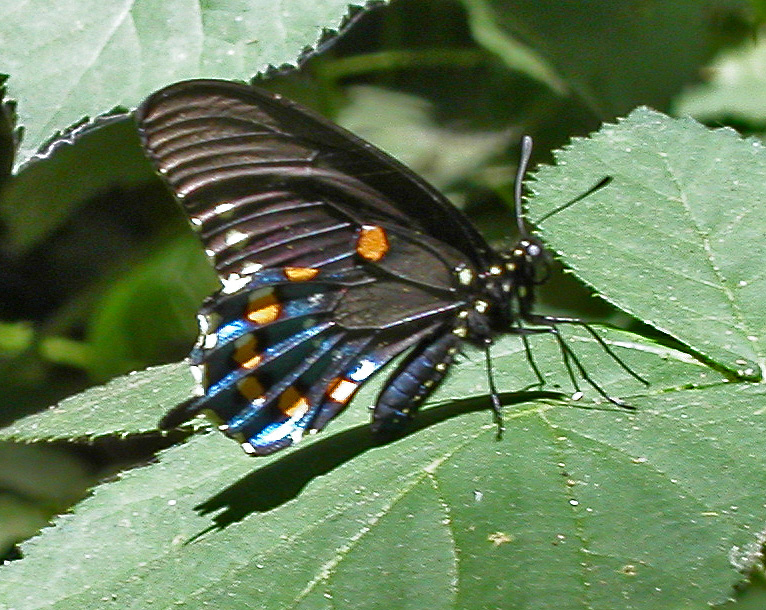|
| Query: Red-spotted swallowtail | Result: 1st of 2 | |
Pipevine Swallowtail (Battus philenor) - Wiki
| Subject: | Pipevine Swallowtail (Battus philenor) - Wiki
| |

| Resolution: 766x610
File Size: 302148 Bytes
Date: 2002:01:01 00:00:00
Camera: DiMAGE F100 (Minolta Co., Ltd.)
F number: f/4.7
Exposure: 10/600 sec
Focal Length: 234/10
Upload Date: 2007:08:14 13:48:41
|
Pipevine swallowtail
From Wikipedia, the free encyclopedia
[Photo] Taken at Lodi Lake in Lodi, CA, by http://en.wikipedia.org/wiki/User:Calibas
The Pipevine Swallowtail Butterfly (Battus philenor) is a swallowtail butterfly which is found in North and Central America.
Range
The butterfly ranges from southern Canada southwards across USA to Mexico, Tres Marias islands and onto Guatemala and Costa Rica.
In the United States, the butterfly is found in New England down to Florida, from Southern Ontario (Canada) to Nebraska, Texas, Arizona, California, Oregon and New Mexico.
Description
The upper surface of the hind wings of the male butterfly has an iridescent metallic blue sheen. The hindwings also have a series of pale, arrow-head markings above and a single row of seven round orange spots, which never touch, set in an iridescent blue field below.
The forewings are dull blackish-brown.
Life cycle
After mating, females lay batches of eggs on the underside of the leaves of a host plant. The caterpillars feed in small groups when young, but become solitary when older. Chrysalis overwinters.
Caterpillar
The caterpillar of the Pipevine swallowtail is reddish-brown. It has rows of fleshy, red or black coloured tubercles on its back.
Host plants
Host plants for the caterpillars include the Pipevine (Aristolochia species), including A. californica, A. serpentaria and others. Pipevines confer a poisonous quality to the larvae and resulting adults, much as the monarch butterfly obtains protection by feeding on milkweed, or heliconiines by feeding on passion flowers.
Nectar resources
Adults seek nectar from flowers, including thistles (Cirsium species), bergamot, lilac, viper's bugloss, common azaleas, phlox, teasel, azaleas, dame's rocket, lantana, petunias, verbenas, lupines, yellow star thistle, buckeye, and butterfly bush.
Mimicry
It is mimicked by the dark-morph Eastern Tiger Swallowtail females which are palatable to predators. This morph is most often found where the two species' ranges overlap. It is also mimicked by the sympatric subspecies of Limenitis arthemis, the Red-spotted Purples.
http://en.wikipedia.org/wiki/Pipevine_swallowtail
| The text in this page is based on the copyrighted Wikipedia article shown in above URL. It is used under the GNU Free Documentation License. You may redistribute it, verbatim or modified, providing that you comply with the terms of the GFDL. |
|
 |
 |

|
Red-spotted swallowtail
1/2 |

|
 |
^o^
Animal Pictures Archive for smart phones
^o^
|
|

